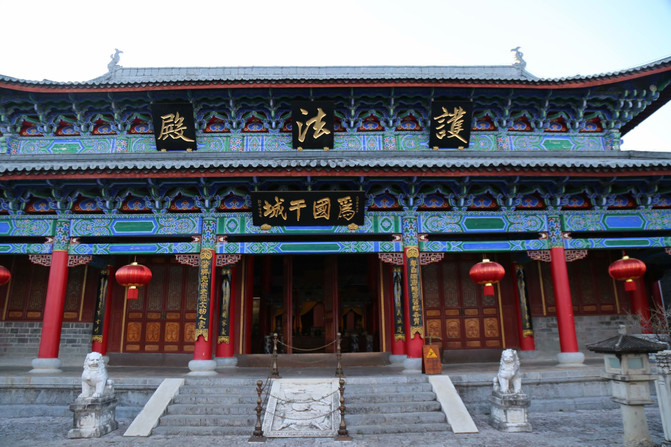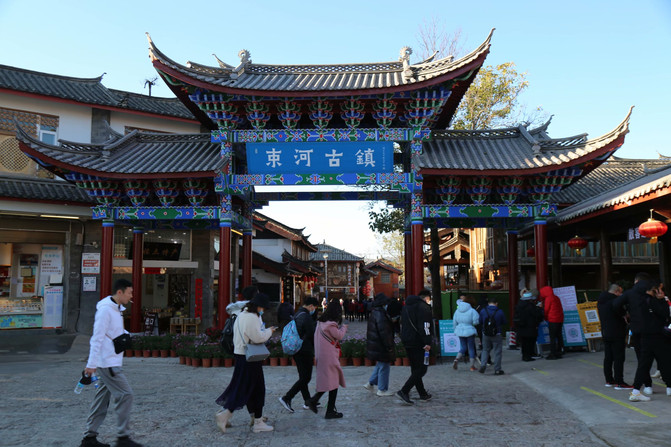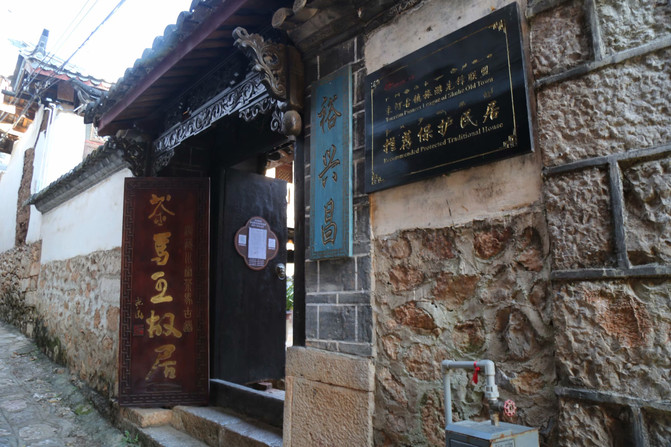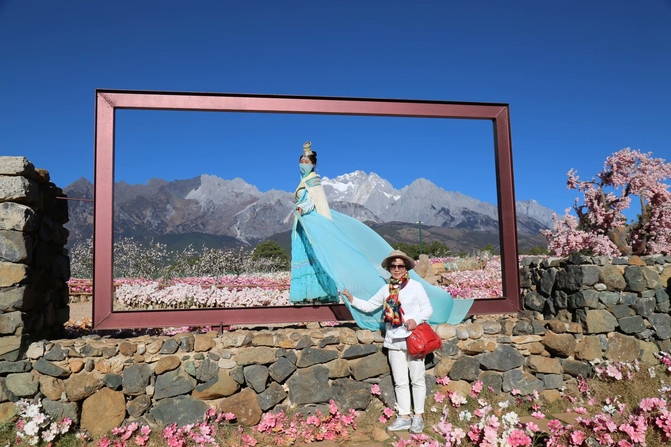(Encounter Lijiang)
On the evening of December 10, after enjoying the eight bowls of the Bai nationality special wedding banquet on Jinsuo Island, we headed straight to Eryuan Jinyi Hotel. Eryuan is the birthplace of Erhai, the pearl of the plateau, and the hometown of dancer Yang Liping. You can't miss it if you walk through it. I got up early in the early morning of the 11th, jogged along Wenbi Road, Jiutai Road, and Xiaoer Line to Cibi Lake, listened to the singing of birds in the lake, enjoyed the night in the sky, and met the beauty of the blue sky and the crescent moon shining in the west.
On the morning of the 11th, we will go to Lijiang to visit Shuhe Ancient Town, Baisha Ancient Town, Dayan Town and Yushuizhai, visit the birthplace of the Naxi people, watch the Yulong Snow Mountain, and watch the real-life performances of Impression of Lijiang and Mufu. The next itinerary centers on Lijiang, storing unnecessary luggage at Hongtai Hotel, going to Shangri-La two days ago, Lugu Lake two days later, and entering and exiting Lijiang three times.
Lijiang has three ancient towns: Baisha, Shuhe and Dayan. Among them, Baisha Ancient Town is the ancient capital of the Naxi people and the origin of the Mu's Tusi regime; Shuhe Ancient Town is one of the earliest settlements of Naxi ancestors in Lijiang Bazi, and it is a living specimen of their transition from farming civilization to commercial civilization; Dayan Town is now the Ancient City of Lijiang, and they are all important parts of the ancient city of Lijiang, a world cultural heritage. I have visited the ancient city of Lijiang several times before, but this time I have visited the old place again.
After arriving in Shuhe Ancient Town from Eryuan, I walked around the ancient town almost all morning. In a few hours, I walked through the streets and alleys. From the parking lot to the ancient town, it is not far from Sifang Street. Sifang Street is not big. There are four roads leading in all directions. It is surrounded by water. It is a city in the middle of the day. There are shops all around it, and there are bright black bluestone roads at your feet. Standing in the middle of Sifang Street, you feel familiar. Sifang Street in the ancient city of Lijiang is a replica of it.
There are nine peaks on the western mountain of Shuhe River, shaped like nine tripods. At the foot of the mountain, there is a pool called the Jiuding Longtan. The pool water flows through front and back houses, and along the vegetable gardens and fields. The water and grass of Longtan dance, clear and transparent, and the Yulong Snow Mountain is reflected in it, with a clear appearance and boundless artistic conception. Above the Longtan is a courtyard house of Sansheng Palace. The foundation of the east building directly enters the water. The west, north and south buildings are dedicated to Guanyin, Dragon King and Sun Bin, the founder of the cobbler. There are corridors on all three sides, and you can see the scenery far and far. Clear springs, ancient trees, ancient temples and the sky wander together, forming a treasure place of feng shui in Shuhe Scenic Area.
The Qinglong Bridge, built by Tusi Mu's family during the Wanli Period, is all built with stones. It is the oldest and largest stone arch bridge in Lijiang Bazi. The bridge deck is gentle, making it easy for horse gangs to walk. It is famous as the "Yanliuping Bridge". After hundreds of years of wind and rain, although it has become mottled and old, it still retains its heroic momentum and solemnity. Standing on the bridge, you may still hear the sound of hooves echoing.
Residential buildings are an extremely important part of the architectural complex of Shuhe Ancient Town. In the residential buildings with three squares and one wall illuminated, flowers are planted in the small courtyard and trees are planted in the courtyard. Some water is diverted into the hospital, water is stored into a pool, and is equipped with pavilions, creating an elegant scenery. As a hub for visiting the Ancient City of Lijiang, Yulong Snow Mountain, Lugu Lake and the Three Parallel Rivers Scenic Area, most of the houses in the ancient town have now been built into inns, and tourists have become mobile residents.
After coming out of Shuhe Ancient Town, after the handover of tour guides Agui and Axiang, we went directly to the Yulong Snow Mountain Visitor Center, first had a buffet lunch, and then moved to the open-air stage to watch the large-scale live-action drama "Impression of Lijiang" with the background of the Yulong Snow Mountain. The actors are all local ethnic minorities. With their rough momentum, native posture and simple singing, they truly demonstrate the indigenous people's feelings for the sky, earth, people and mountains, cleansing their souls and bringing tears to people. The huge theater was full of tourists. After the performance, they were told that the wind was strong on the mountain and the Yulong Snow Mountain cableway had been closed.
There were three trips to the Jade Dragon Snow Mountain. One time he looked into the view from the observation deck, and the other time he couldn't go up due to rain. This time, Ah Xiang finally bought a ticket for the cableway online. If you can't get to Glacier Park to experience the charm of snow-capped mountains and glaciers up close, you will take a small cableway and then change to a battery car to go to Blue Moon Valley. Many people flocked to the small cableway, so much time was wasted in queuing.
Got off the battery car and walked two or three kilometers to Yunshanping. This is an alpine meadow surrounded by spruce trees and clusters of flowers. It is called "Wulu Youcuige" in Naxi, which means a place to die for love. In ancient times, it is the spiritual home where young men and women in Naxi pursued perfect love. The meadow covers an area of about one square kilometer and has an altitude of more than 3200 meters. The snowy mountains on the west side are towering and are surrounded by virgin forests. However, there are no trees in the middle, and it becomes a pasture due to the lush pasture.
The Naxi Dongba classic "Lu Ban Lu Rao" depicts Yunshanping as an ideal paradise where white deer serve as farming oxen, red tigers serve as mounts, pheasants come to announce the dawn, white clouds brew wine, golden fruits grow on trees, and cleanliness and no flies. That is, the "Jade Dragon Third Country" in the legend of the Naxi people. Here, the majestic Yulong Snow Mountain is close at hand, the thousand-year glaciers are clearly visible, and the story of Kaimei and Yu Lepai, the founding fathers of the Naxi people's love and death, is sad.
His wife had some altitude reaction and spent a lot of time commuting to and from the alpine meadow. By the time we returned to Lanyue Valley from Yunshanping, the sun had already set in the west. Lanyue Valley is commonly known as Baishui River. The river water is blocked by mountains during its flow, forming four larger water surfaces, namely Guanyuye Lake, Jingtan Lake, Lanyue Lake and Tingtao Lake. When I passed by Yunshanping, I looked down at the bottom of the lake and the mud was as white as sand, and the water was as blue as jade. When I came to the lake, the water had turned into a faint milk color. Under the action of different weather and light, the lake water in Blue Moon Valley will show different colors.
On the morning of the 12th, A Xiang led us to continue exploring the Yushui Village, the holy place of Dongba Religion. The stockade is backed by the Yulong Snow Mountain and faces Lijiang Dam. It is the ancestral treasure of Feng Shui of Naxi and the birthplace of Naxi culture. Walking into the gate of Yushuizhai Scenic Area, the first thing that comes into view is the clear and ethereal water features. A clear spring flows out from under the two old trees and runs down the mountains, stacked on top of each other, forming the famous "Chulong Waterfall","Playing Dragon Waterfall", and "Sending Dragon Waterfall", known as the Shenlong Sandian Water. Tracing back to the source, we come to the Shenquan, which is the place where the Jade Dragon Mountain God enters and exits. It is the spring of life of the Naxi people. The spring water gushed out from the cracks in the stones, green and pure, and clear.
Yushui Village is also the inheritance base of Dongba culture. The scenic area has Dongba Bi Gallery, Dongba Ancestral Temple, traditional sacrificial grounds, Naxi ancient buildings and their traditional waterwheels, water pestle, water mill houses, white sand music and Dongba Dance display, etc., the traditional and simple Naxi style complements the beautiful natural landscape around. Walking into the stockade, several young Naxi men and women were sitting around. Ancient music was playing and they danced with the joy. The group members first watched it, and then couldn't help but join in. They first relaxed and then became familiar with it, and the more they danced, the more energetic they became.
The scenic area is not big, so half a day is more than enough. While others were dancing, a Naxi elderly man in his 70s was in full swing and was burning a fire in front of the stove to make wine. I walked to the entrance of the brewery, and he stood up to welcome me in. This is an ancient folk wine-making process in Naxi. The koji used for fermentation is made of medicinal herbs and wheat bran bran. The raw materials are pure grain grains such as barley, wheat, and corn. The koji is cooked, mixed with the koji for fermentation for about a month, and put into a steamer. The steamed liquid is wine. While we were chatting, he poured a cup of 48-degree old wine for me to taste. I took the cup and smelled it before drinking it. The fragrance was pleasant and the aftertaste was endless. I bought a bottle on the spot to take it on the journey.
With the help of dancing, A Xiang put on a coir coat, simple and handsome. His wife took the lead, and other group members rushed to take photos with him, which not only delighted Ah Xiang, but also brought the guide closer to the tourists. A Xiang has repeatedly expressed that he would upload the photos to their company's website, and I also sent the photos to him as promised. In this way, we bid farewell to the tour guide and group members in a pleasant atmosphere. After lunch, we got on another bus and started our trip to Shangri-La with the regrouped group members.
The last time I returned to Lijiang was a few days later, on the evening of the 15th. It was nearly midnight after cooking instant noodles at the hotel. I got up at 4 a.m. on the 16th and jogged for 10 kilometers along Minzhu Road, Kangzhong Road, Yuxue Road and Shangri-La Road. Starting at 9 o'clock in the morning, a driver surnamed Li drove a small car and accompanied us and a young man and woman from Fujian to visit the Dongba Secret Scenic Area.
This is a Mufu Fengyun landscape scenic spot built with the Yulong Snow Mountain and the Abyssal Canyon as the background, with "Mufu Fengyun" and Lijiang culture as the source. The area has dense vegetation, many flowers and plants, and stones painted with different color patterns are dotted in it. These green plants and buildings with strong Naxi style reflect the majestic and majestic Yulong Snow Mountain from different angles. We first followed the plateau grassland and then followed the ancient tea-horse road through the canyon. We watched the natural scenery of the snow-capped mountains and canyons, and watched the immersive Mufu Fengyun Landscape Show, which was quite shocking.
During the performance at the Mufu Gold Mine, a pair of group members from Fujian were selected as extras. After becoming gold mine thieves for a time, they were given a pair of "golden ingots" and exchanged for two rice noodles at the food street at the end of the canyon. They have been waiting on the street, asking us to share. Their persistence embarrassed us, and their courteous invitation moved us. We walked into the restaurant and sat around a small square table, as if we were family in the eyes of others.
After lunch, the second leg of the journey ends. We walked into the ancient city, followed the crowd of people, wandered aimlessly to the Shishan Observation Deck, and sat down at a coffee shop. This is a space built on the top floor of the house, open on three sides and shaded from the sun. It is condescending and provides a panoramic view of the entire ancient city. The three open sides of the coffee shop are already filled with young people. Some are holding fruit juice and silently staring at the beautiful scenery and taking selfies, and some are lowering the brim of their hats to bathe in the sun. They spend time together without interfering with each other.
Time passed by in a daze. At around 4 o'clock in the afternoon, I suddenly thought of Mufu and bid farewell hurriedly. Before closing the door, he followed the last groups of people to visit the Mu's Tusi Yamen. This is the heart of the 800-year-old Dayan Ancient Town. The entire building faces west to east, with its back resting on Lion Mountain. On the central axis, there are halls such as the Council Hall, Wanjuan Tower, and Dharma Hall. There are houses on both sides, towers, pavilions, and countless., garden corridors, unique style. The jade ditches in the mansion are vertical and horizontal, and the living water is long. The grandeur of the building, the glory of the palace, the exquisite components, the exquisite components, and the brilliance of the paintings are truly beautiful and unparalleled.
The Naxi people originally had no surnames. After Zhu Yuanzhang established the Ming Dynasty, Ajia Ade, the chief of the Naxi nationality in Lijiang, assessed the situation, surrendered, and was greatly appreciated. Zhu Yuanzhang removed his surname and gave it the surname Mu. The word Mu and the word Ren were Zhu, indicating that Ajia Ade was a member of the Zhu family. From then on, the traditional Naxi father-son system was changed to the Han surname. There are no city walls built around the ancient city. Wood Tusi lives in the home. Once the city wall is built, it is equivalent to adding a frame to the word "sleepy", which is tantamount to trapping the wood.
Mu believed that the surname Mu was given by the emperor and could only be exclusive to Mu nobles. As for the common people, Mu followed Zhu Yuanzhang's approach and gave a He surname to the common people other than Mu. For the indigenous people in Lijiang, the surname He means adding a tip on the wood, which means wearing the Mu family's hat, and adding a bite next to it means carrying the Mu family's basket, which means that the surname He is the servant of the Mu family. In the Ming Dynasty, other foreign families in Lijiang had to change their surnames to He. For them, the meaning of He was slightly different. There was a flap on the wood, which meant giving you a piece of heaven for the Mu family, and the bite next to it meant that the Mu family would give you a bite of rice. Eat, which means welcoming outsiders to become the common people of the Mu family. This is the official surname Mu and the people's surname He recorded in historical books. The rule that foreigners must change their surnames and He when they come to Lijiang lasted until the Qing Dynasty, when the land was changed and returned to the flow.
There is a wooden archway next to the Mufu house with the words "Rain Flowing Fragrance" written on it, which is particularly interesting. In Chinese, it means that the sky rains and breeds all things. In fact, it is a transliteration of Naxi, written on the archway like water and water. Its Naxi means "go and read". The two tones of Na and Han, and the other pun, reflect the wisdom and wisdom of the Naxi people in advocating knowledge. Indeed, reading a good book nourishes the mind like rain does to the ripeness of grain. It makes our hearts bathe in the mighty fragrance of wisdom and feel extremely happy and peaceful.
The trip to Lijiang was unforgettable, from the Naxi director, ancient town, Yunshanping, birthplace, to the Naxi civilization, from Mufu and Mufu real-life performances, to anecdotes of the Naxi people, from the step-by-step journey, to the ancient city's pressure on the road and blowing, we met the most beautiful scenery. (Winter Travel Yunnan Diary 11 2020.11.28 - 12.23 Tour 1.13 was written in Zhuhai)

(Hongwei Mufu)

(Glorious Palace)

(Mufu Yamen)

(Wanjuan Tower)

(Dharma Hall)

(Council Chamber)

(Meeting Hall)

(Exquisite carving)

(Mufu Promenade)

("Go to study" archway)

(Impression Lijiang performance stills)

(Entrance of Shuhe Ancient Town)

(Naxi script)

(Shuhe Wanxiao)

(Gu Dao Newcomer)

(Shuhe Sifang City)

(Shilian Ancient Temple)

(Former Residence of Tea Horse King)

(Fragrant fruits)

(Yushui Village)

(Sanshiquan)

(Dongba Temple)

(God of nature)

(Dongba Dance)

(Burn the fire to brew wine)

(Naxi wine making)

(Stone engraved with Dongba script)

(Stills of Mufu Fengyun Performance)

(Fairy descends to earth)

(Naxi totem)

(Under Yulong Mountain)

(Tea tells the ancients)

(Under the Lion Rock)

(Dancing Sifang City)

(Internet celebrity street)

(Flying flowers on ancient streets)

(Jiang Zemin's inscription)
Previous Article:Go to Lijiang and steal two days of leisure
